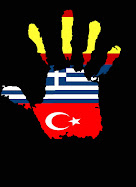
El 9 de mayo de 1950, Robert Schuman presentó su propuesta para la creación de una Europa organizada, requisito indispensable para el mantenimiento de relaciones pacíficas.
Esta propuesta, conocida como "Declaración Schuman", se considera el germen de la creación de lo que actualmente es la Unión Europea.

El 9 de mayo se ha convertido en el símbolo europeo (Día de Europa) que, junto con la bandera, el himno, el lema y la moneda única (el euro) identifican la entidad política de la Unión Europea. En el Día de Europa se celebran actividades y festejos que acercan a Europa a sus ciudadanos y hermanan a los distintos pueblos de la Unión.
Podéis ver la colección completa de los carteles publicitarios del Día de Europa pinchando aquí.
On May 9th, 1950, Robert Schuman proposed the creation of an organized Europe, as an essential requirement for pacific connections.
This proposal known as “The Schuman declaration” is considered to be the source germ of what nowadays is the European Union.
May the 9th has become the European symbol (The Day of Europe) which, together with the flag, the hymn, the slogan and our common currency (the Euro), identify the political entity of the European Union.
In the Day of Europe a lot of activities and events are celebrated. They approach Europe to its citizens and unite the different countries within the Union.
This proposal known as “The Schuman declaration” is considered to be the source germ of what nowadays is the European Union.
May the 9th has become the European symbol (The Day of Europe) which, together with the flag, the hymn, the slogan and our common currency (the Euro), identify the political entity of the European Union.
In the Day of Europe a lot of activities and events are celebrated. They approach Europe to its citizens and unite the different countries within the Union.










0 comentarios:
Publicar un comentario